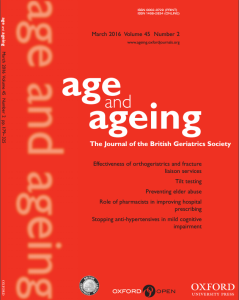Palliative care for frail older people: what, when and how?
Anna Bone is a Cicely Saunders International PhD Training Fellow in the Department of Palliative Care, Policy, and Rehabilitation at King’s College London. In this blog Anna discusses her recent Age and Ageing paper on developing a model of palliative care for frail older people. This is part of the OPTCare Elderly Study, a joint project between King’s College London and Sussex Community NHS Foundation Trust, led by Dr Catherine Evans. @AnnaEBone

In the minds of many, palliative care is synonymous with cancer and end of life. This is unsurprising, as it is within this context that palliative care has developed. The goal of palliative care is to relieve suffering and improve the quality of life of people with life threatening illness. It is increasingly believed that palliative care has much to offer to other patient groups whose health is deteriorating, and not just at the end of their life. People are now living longer, with multiple chronic illnesses and frailty, and dying at older ages. We need to consider the needs of this growing group. Specialist palliative care services for frail older people with deteriorating health may provide an extra layer of support to help them and their families live as well as possible. However, applying the standard model of palliative care to frail older people is problematic. For older people with non-cancer illnesses the end of life phase is difficult to predict and so, unlike for cancer, we cannot rely on a diagnosis to trigger a referral to palliative care. When, therefore, is the best time for a referral to palliative care? What are its possible benefits? How can palliative care be integrated into existing health services to support older people and their carers?
We aimed to develop a model of palliative care for frail older people living at home or in a care home. Informed by previous work, we proposed a short-term intermittent service delivered by a specialist palliative care team working in an integrated way with GPs and community nurses. To shape the elements of this model of care we sought the views of key stakeholders. Using a combination of focus groups, consultations and a follow-up consensus survey we engaged a broad range of people including older people, carers, health professionals and researchers. We asked for their views on the possible benefits, timing of referral, and ways to integrate this model into existing services. We found that stakeholders considered specialist palliative care acceptable for older people with non-cancer conditions. Stakeholders agreed that it could benefit patients and families in a number of ways, including management of complex symptoms, planning future care, and providing reassurance to carers. It was suggested that referrals should start early when the person is vulnerable to decline to establish a relationship with the team, but also when the person’s health is deteriorating. Timing of referral must balance the possible benefits of early intervention with the reality of finite specialist resource. An important feature of integrated working was a skilled key worker identified from the team with most involvement with the older person and family, to coordinate care. A single point of access to palliative care services for older people and carers and also for referring health services was considered important.
Key stakeholders agree that a model of short-term integrated palliative and supportive care for frail older people with non-cancer conditions has potential benefits for older people and carers within community settings, but differ in opinion on the optimal timing and indications for this service. The model now needs testing to firstly assess the feasibility of delivering it in the existing health system, and secondly to evaluate its effectiveness in improving outcomes for older people and carers. We need robust evidence to inform a much needed shift in provision of care for frail older people.
Read the full Age & Ageing article 'Developing a model of short-term integrated palliative and supportive care for frail older people in community settings: perspectives of older people, carers and other key stakeholders'
Comments
Add new comment